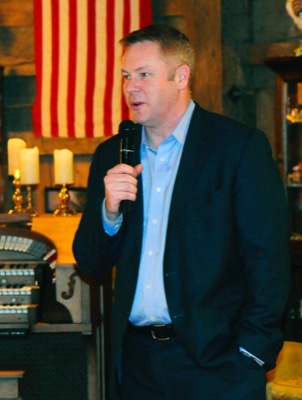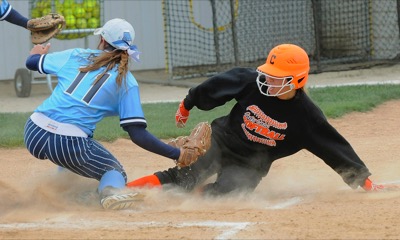Monday, April 24th, 2017
Museum expansion fundraising at halfway
By Sydney Albert

Photo by Mark Pummell/The Daily Standard
Christopher Burton, director of the Armstrong Air and Space Museum, stands next to the Gemini Spacecraft. The museum is planning a multimillion, three-part expansion that will enable organizers to add more exhibits like this one.
WAPAKONETA - Armstrong Air and Space Museum officials are about halfway to their fundraising goal for a $2.9 million expansion project.
The project is the first of three proposed expansions and is estimated to cost a total of $9.72 million, museum director Christopher Burton said.
The first project will include developing and improving the existing building with projects such as adding classroom space, improving museum layout with room for additional exhibits and converting the dome theater into a functioning planetarium.
"The big chunk has come from the state," Burton said. "We have $1.4 million right now, including that state appropriation."
State documents showed $900,000 had gone to the museum for a STEM education center
Though the project is still in the early phases with nothing set in stone, Burton said museum officials would like to have their donation commitments in place by October, which would enable construction to begin between October and February. He said the ideal reopening date would be July 2019.
"We're not really asking the public for money. We're trying to get money from major corporations in the area as well as major corporations in the air and space field, aerospace contractors and also some federal money through NASA," Burton said.
The museum is still trying to build relationships with prospective donors, he added, as they don't have a set list of established donors. Burton said the museum hasn't asked for money since it was first built in 1972, when the community raised $500,000 to match state funds for initial construction.
"People are getting to know the museum as a foundation for the first time," Burton said.
Expanding the museum is necessary to keep up with the changing nature not only of the museum's space exploration focus but of how people interact with museums, he noted.
"I've been here for a little over seven years now, and so when you get to know the museum, you see a lot of deficiencies," he said. "Also we've grown quite a bit. When the museum was built in 1972, there was no classroom and exhibits were built differently. People would walk through the museum, they looked at things, and it was kind of like a conveyor belt."
People today want to experience more when they visit a museum, Burton added.
"They want to play, they want to do, they want to experience," he said. "Those things take more time, they take more room. ... So we're just trying to have the museum reflect that."
Burton called the museum's current layout inconvenient. It has classroom space near the center. If children attend a class or event and want to use the bathroom, they have to walk up to the front of the museum and then all the way back, he said, noting the classroom space itself is "comically small."
"We kind of built a classroom out of nothing, so it's certainly better than having nothing, but to have 20 or 30 kids in there can be really tight," he said.
Lack of space is a main reason museum officials limit programs such as astronaut camp or why they must turn away school classes looking to visit, Burton said.
In the first phase, the new classroom space would be closer to the entrance and bathrooms, and would be big enough museum personnel could teach two classes at the same time. The demand for the expansion is great, Burton said. Officials need to fill that need.
Bypasses would be built around the dome theater to make it into a proper planetarium where shows would be held at certain intervals. Now visitors must walk through the theater to reach the rest of the museum. The facility was first designed to have visitors finish their tour at the theater, where they would watch a short film about the moon landing.
However, in 1999 a small expansion, the Modern Space Gallery, was added to the opposite side of the theater. Burton said if the funds are raised, the gallery would be expanded into three different rooms that would cover the space shuttle, the International Space Station, Mars exploration and other robotic exploration throughout the solar system. More hands-on activities also would be added.
The second phase would construct a $5.5 million visitor center at the front. It would include a lobby and admissions areas, a large exhibit hall, a 150-seat meeting room, two classrooms/labs, restrooms, a new museum store, a catering kitchenette and food service area, a loading dock and storage areas. Burton did not have an exact size for the proposed center but said that between the exhibit gallery and the classrooms about 8,500 square feet of public activity space would be added.
The third and final phase of the expansion would include the acquisition and restoration of Armstrong's boyhood home at 601 W. Benton St., Wapakoneta, as a 1940s interpretive center, which museum officials estimate would cost around $1.321 million.

Photo by Mark Pummell/The Daily Standard
The Armstrong Air and Space Museum uses the Modern Space Gallery as a banquet room for events. The museum is planning a multimillion, three-part expansion.




